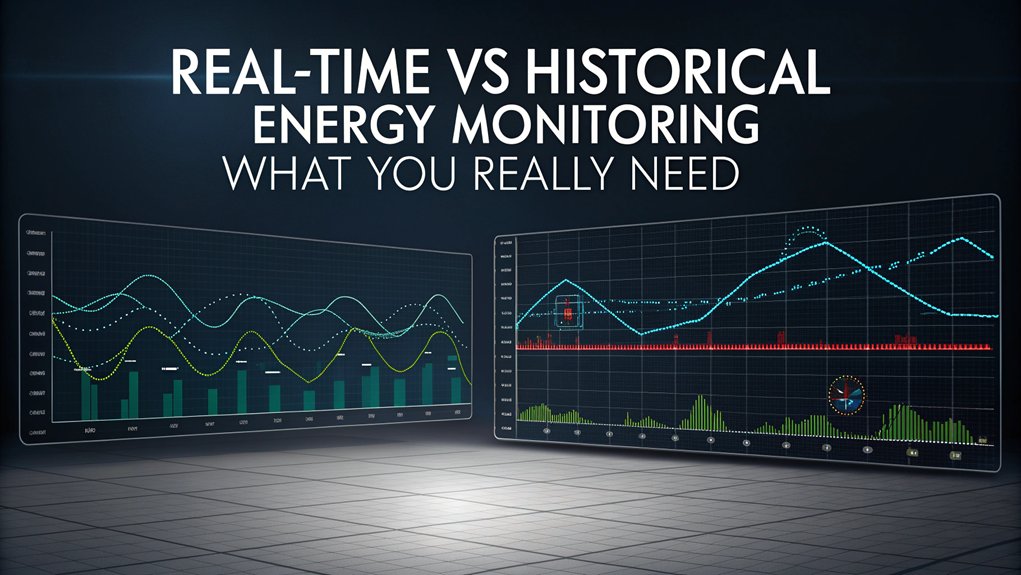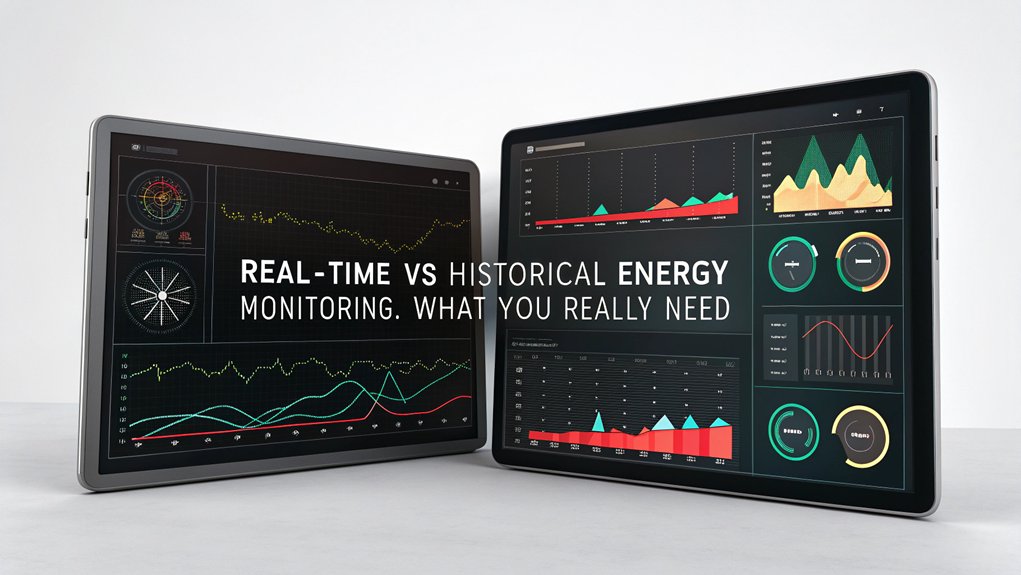Choosing between real-time and historical energy monitoring depends on your needs. Real-time monitoring gives immediate insights, letting you quickly act on inefficiencies, while historical data helps identify long-term consumption trends. Both have benefits: real-time systems optimize energy use instantly, while historical analysis supports strategic planning. Consider your goals, like cost reduction or sustainability, when selecting a system. By exploring further, you’ll uncover which monitoring approach aligns with your objectives.
Key Facts Summarized
- Real-time monitoring provides immediate insights, enabling quick actions to optimize energy efficiency and reduce costs.
- Historical monitoring offers trend analysis over time, useful for strategic planning and long-term efficiency improvements.
- Real-time data ensures proactive energy management, while historical data supports identifying recurring patterns and inefficiencies.
- Integration of AI in real-time monitoring enhances decision-making by analyzing patterns and predicting future energy needs.
- Both monitoring types complement each other, with real-time data driving immediate actions and historical data guiding long-term strategies.
Understanding Real-Time Energy Monitoring
In today’s energy-conscious world, understanding real-time energy monitoring is essential for optimizing efficiency and sustainability. By tracking and analyzing energy consumption as it happens, this approach offers immediate visibility into usage patterns.
You’ll employ IoT sensors and smart meters to collect data, which is swiftly transmitted for real-time analysis. This system is vital for detecting energy usage spikes, enabling quick action to correct inefficiencies.
As a result, you can achieve significant cost savings, with potential utility bill reductions supported by data-driven decisions. Real-time monitoring promotes energy efficiency, often leading to an average of 30% energy savings, as seen in IBM’s data centers.
Ultimately, implementing these practices supports sustainability by identifying excessive consumption and encouraging efficient energy use.
The Technology Behind Real-Time Monitoring
Leveraging cutting-edge technology, real-time energy monitoring hinges on the seamless integration of IoT sensors, cloud computing, edge computing, AI, and blockchain.
IoT sensors continuously track energy consumption, providing real-time data that enhances your visibility. This data is immediately processed through cloud computing, which aggregates and stores vast datasets, enabling advanced analytics for informed energy management.
Edge computing preprocesses information locally, reducing latency and allowing you to respond swiftly to consumption patterns.
Artificial intelligence plays a vital role, analyzing these datasets to identify patterns and optimize energy efficiency.
Blockchain guarantees data integrity and security within energy monitoring systems, making sure the information is both accurate and trustworthy.
Together, these technologies revolutionize your approach to real-time energy monitoring.
Historical Energy Monitoring Explained
While real-time energy monitoring offers immediate insights, understanding the broader picture requires a look into historical energy monitoring. By collecting and analyzing historical data, you gain a thorough view of energy consumption patterns over time. This enables you to identify trends and performance bottlenecks essential for effective energy management.
Analyzing historical data helps in capacity planning and forecasting, as you can predict future energy needs based on past consumption behaviors. Regular performance reviews using historical insights facilitate continuous improvement, driving operational efficiencies and cost savings.
In addition, integrating historical analysis with real-time data enhances troubleshooting and predictive capabilities. This approach fosters proactive energy management strategies, optimizing application performance and aiding in the achievement of energy efficiency goals and sustainability commitments.
Comparing Real-Time and Historical Monitoring
Although both real-time and historical energy monitoring play pivotal roles in energy management, their distinct functionalities cater to different needs.
Real-time energy monitoring offers immediate insights, enabling you to quickly adjust and manage energy consumption. It continuously collects data, allowing for rapid responses to anomalies, which can lead to up to 41% reduction in energy use.
In contrast, historical data analysis excels in identifying long-term trends, helping you optimize future energy strategies and make strategic investments.
While real-time monitoring focuses on immediate issues, historical analysis supports long-term planning.
Benefits of Real-Time Energy Monitoring
Real-time energy monitoring, by providing immediate insights into energy usage, empowers businesses to detect inefficiencies and address them promptly, resulting in significant cost savings. With IoT sensors and AI analytics, you can optimize energy consumption, reducing expenses by up to 41%, as shown in studies like the U.S. GSA’s.
| Benefit | Description |
|---|---|
| Immediate Insights | Detect energy spikes and inefficiencies instantly. |
| Energy Savings | Achieve up to 41% cost reduction. |
| Regulatory Compliance | Stay updated and avoid penalties. |
| Environmental Impact | Reduce carbon footprint with timely adjustments. |
| Data-Driven Decisions | Leverage AI to enhance operational efficiency. |
Real-time monitoring not only guarantees compliance with sustainability standards but also optimizes operations, translating data into actionable strategies. This proactive approach promotes energy savings and lessens environmental impact.
Benefits of Historical Energy Monitoring
When seeking to optimize energy management, historical energy monitoring serves as a powerful tool, offering a wealth of insights into long-term consumption trends.
By delving into historical data, you can identify patterns and inefficiencies, enabling strategic decision-making that enhances energy efficiency. Analyzing past performance allows you to pinpoint recurring issues, leading to targeted interventions that reduce waste.
Historical data also supports effective capacity planning, forecasting future energy needs with precision, and facilitating accurate budgeting and resource allocation. Regular reviews help uncover performance bottlenecks, informing continuous improvement initiatives.
Challenges in Implementing Monitoring Systems
Implementing energy monitoring systems, especially in real-time, poses several significant challenges that can impact their adoption and effectiveness. Start-up costs for hardware and software can be prohibitive, particularly for smaller businesses seeking cost savings. Managing large data volumes requires skilled personnel, adding to operational challenges. Integration with existing systems demands a thorough evaluation of infrastructure, which can be intricate and time-consuming. Ensuring data accuracy is another hurdle, as highlighted by issues in the Solar Energy Data Portal project. Balancing these initial challenges with potential long-term efficiencies necessitates strategic planning and a deep understanding of energy patterns.
| Challenge | Impact |
|---|---|
| High Start-up Costs | Barrier to adoption |
| Data Management Complexity | Increased operational costs |
| Integration Difficulties | Time-consuming assessments |
| Data Accuracy Issues | Potential inaccuracies in monitoring |
| Planning Requirements | Essential for balancing cost savings |
Choosing the Right Monitoring System for Your Needs
Selecting the right energy monitoring system demands a thorough analysis of several key factors to guarantee it meets your facility’s specific needs.
Start by evaluating your electrical setup; a single-phase or three-phase load affects compatibility. Precision is essential, so assess the accuracy requirements for your applications. If you need real-time information, confirm the system provides immediate updates, critical for effective energy management.
Also, consider the installation environment—your monitoring system must integrate seamlessly with existing infrastructure.
Compare market options; some systems offer advanced features like IoT connectivity and data analytics. These can enhance your energy management strategy, providing insights for better decision-making.
Future Trends in Energy Monitoring
As the landscape of energy monitoring evolves, the integration of artificial intelligence (AI) and machine learning (ML) is set to revolutionize the way businesses manage energy consumption.
Predictive analytics will empower you to anticipate and optimize usage patterns, allowing for smarter real-time energy management. Coupled with IoT-enabled devices, you’ll gain access to granular data collection, enhancing operational efficiencies across your energy-consuming assets.
Blockchain technology will bolster data security and integrity, ensuring transparency and trust in your energy transactions.
The market for energy control systems is projected to grow considerably, driven by sustainability goals. Future systems will focus on user-friendly interfaces and customizable dashboards, making complex data accessible and actionable, thereby transforming how you approach energy consumption.
Frequently Asked Questions
What Are the Benefits of Real Time Energy Monitoring?
You gain immediate detection of energy spikes with real-time monitoring, allowing quick action to cut costs.
Companies like IBM saw a 30% drop in data center energy use.
You’ll get detailed insights into your power patterns, enabling data-driven decisions for upgrades and efficiencies.
Stay compliant with sustainability standards through up-to-date readings, avoiding penalties.
Identify peak times for enhanced environmental preservation and cost savings.
Are Home Energy Monitors Worth It?
You’re considering if home energy monitors are worth it, and the data strongly suggests they are.
By offering real-time insights into energy consumption, these devices can help you cut down up to 25% on utility bills.
With advanced IoT sensors, they pinpoint energy waste, often found in unoccupied spaces.
Although there’s an initial investment, many users recover costs within a year.
The potential for long-term savings and energy efficiency improvements makes them valuable.
What Is the Best Way to Monitor Electricity Usage?
To monitor electricity usage effectively, you should combine real-time monitoring with historical data analysis.
Real-time systems let you address inefficiencies immediately, potentially cutting costs by up to 30%, as IBM found in data centers.
Analyzing historical data helps you identify patterns, making informed decisions for future energy use.
Adopt a hybrid approach for a thorough view, ensuring your chosen system meets your specific energy loads and accuracy requirements for peak performance.
What Is the Alternative to Sense Energy Monitor?
Are you looking for an alternative to the Sense Energy Monitor? Consider the Emporia Vue, which delivers real-time insights at a competitive price.
Have you tried Neurio? It offers detailed consumption analysis through an intuitive app.
TP-Link’s Kasa Smart Plug lets you manage device-specific usage remotely.
EnergyHub integrates seamlessly with smart homes, while Efergy Engage Hub provides user-friendly real-time monitoring.
Each option offers unique features to enhance your energy management.
Conclusion
Imagine your energy usage as a leaky faucet. Real-time monitoring is like a plumber at the ready, fixing leaks as they happen, while historical monitoring provides a detailed water bill, showing patterns over time. Both have their place. Real-time is essential for immediate efficiency, while historical offers strategic insights. When choosing a system, consider your needs: immediate action or long-term strategy. Remember, combining both approaches often yields the most thorough energy management solution.

